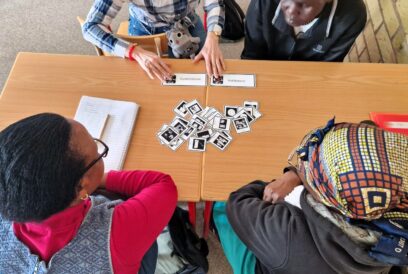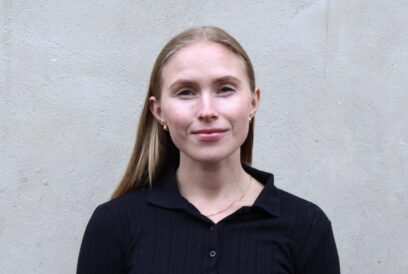

AYICC Zimbabwe’s National Coordinator Jean-Betrand Mhandu knows that in rural communities, the conversation on climate change is often based on needs, culture, weather and water. Photo: Hanne-Mari Tarvonen
Climate change education requires different tools in urban and rural settings
Published:AYICC Zimbabwe’s National Coordinator Jean-Betrand Mhandu knows that in rural communities, the conversation on climate change is often based on needs, culture, weather and water. Photo: Hanne-Mari Tarvonen
African countries suffer disproportionately from the consequences of climate change, but have little control over climate policy.
Accelerating climate change with water stresses, withering droughts and extensive floods are hitting African communities throughout the continent. Disrupted rainfall patterns, disappearing glaciers and shrinking main lakes are signs of an increasing water crisis.
Even though Africa only accounts for about 2–3% of global greenhouse gas emissions, its countries suffer disproportionately from the consequences of climate change, according to The State of Climate in Africa 2021 report.
The report focuses on water. High water stress will affect about 250 million people in Africa and is expected to displace up to 700 million people by 2030.
People know it’s too hot, and something needs to be done. They are aware that rain patterns have changed, and that it’s due to climate change.
According to the World Meteorological Organization WMO’s Secretary General, Professor Petteri Taalas, Africa’s climate has been warming by more than the global average since pre-industrial times (1850–1900). According to the professor, sea level rise along African coastlines is faster than the global mean, contributing to increases in the frequency and severity of coastal flooding and erosion, and salinity in low-lying cities.
Climate funds need better coordination
At the 2009 Copenhagen climate negotiations, developed nations committed to provide scaled up, new and additional, predictable and adequate funding to meet “a goal of jointly mobilizing US$100 billion per year by 2020 to address the needs of developing countries.”
But the promise has had deep flaws, making it impossible to assess whether it has been met.
According to Nature magazine, developing countries expected the funds promised to be dominated by public grants directed through the UNFCCC Green Climate Fund. There, the nations would have had their own representatives empowered to help decide the direction of funds flows, and they could be coordinated and targeted better.
But what happened is quite the opposite: climate funds are being funnelled through over 100 channels. Very few are controlled in meaningful ways by developing nations. These include developed countries’ aid and export promotion agencies, private banks, equity funds and corporations, and the lending and granting branches of multilateral institutions such as the World Bank.
Local organisations taking concrete action
The developed countries have clearly failed in funding developing countries sufficiently for them to adapt to and mitigate the consequences of climate change.
In November 2022, the COP27 meeting in Egypt gathered together thousands of officials, experts and representatives from all around the world to discuss what needs to be done urgently.
Many experts of the global south are demanding more immediate action instead of exhausting conversations that do not seem to lead to concrete actions.
But there are many local organisations all around Africa already acting. One of them is AYICC, African Youth Initiative for Climate Change. In Zimbabwe, AYICC is working with approximately 30 different youth organisations focusing on climate and the environment. AYICC is a platform accommodating other organisations through mailing lists, focus groups, partner ideas and workshops. Members are young, between 16 and 35 years old.
Young people find AYICC via social media platforms, traditional media exposure, campaigns and events. Every Thursday, the organisation holds a climate talk on a local radio station to talk about climate issues.
“Peer-to-peer engagement is easy, because the organisation comprises young people,” says AYICC Zimbabwe’s National Coordinator Jean-Betrand Mhandu.
Young people see that the climate is changing
According to Mhandu, the question in Zimbabwe is not whether young people care about the environment.
“The question is often whether they have the time and resources to address the issues related to climate change and the environment.”
“People know it’s too hot, and something needs to be done. They are aware that rain patterns have changed, and that it’s due to climate change. Zimbabweans have a close connection with nature and we can see things are changing,” Mhandu explains.
We map out the different challenges in the area and changes that have been occurring through the years. We listen to their experiences and thoughts for solutions.
According to him, many of the climate related conversations are carried out in English, instead of people’s local languages.
“That alone widens the gap; some are equipped to talk about climate change and environment in English in spaces where the frameworks are being discussed and decided. But there are many who lack the language skills to address the issues they might be thinking about.”
Different approach in rural communities
In rural communities, climate change is not being discussed in scientific terms – the conversation is more based on needs, culture, weather and water.
Jean-Betrand Mhandu emphasises that decisions and discussions used to take place on a community level; people addressed their issues, and the community would act based on them.
Now the decisions and policies about climate change and the environment are mainly the responsibility of the ruling party and ministries.
It is difficult to pass on information and teach young members in the rural communities, mainly due to the language barrier and illiteracy. Sometimes translators are required, as well as the ability to explain environmental policies and frameworks in an understandable way.
Complex topics require a variety of tools
Especially in rural communities, AYICC engages via collaborative research. It finds focus points and ask questions of the locals so that they feel comfortable in addressing the challenges. AYICC exchanges knowledge and ideas with the communities to comprehend what is the best way to tackle the challenges.
The more complex the topic, the more approaches and tools are needed for understanding. Simplifying a phenomenon or theme and portraying it through a character or focusing on a strategy and implementation plan helps with teaching.
“We map out the different challenges in the area and changes that have been occurring through the years. We listen to their experiences and thoughts for solutions. Then we can teach the science behind climate change,” Mhandu explains.
“We have to explain that there are main polluters, efforts towards mitigation and adaptation – and what our position is as part of the African coalition.”
In addition to teaching about climate change, AYICC does tree planting, offers seeds to locals, facilitates environmental and street clean-ups and does market gardening with communities.
On top of climate change, young members learn about food security and biodiversity – and can directly be part of the change in their own communities.
Author







